
The Heptanese school of painting succeeded the Cretan school as the leading school of Greek post-Byzantine painting after Crete fell to the Ottomans in 1669. Like the Cretan school, it combined Byzantine traditions with an increasing Western European artistic influence and also saw the first significant depiction of secular subjects. The school was based in the Ionian Islands, which were not part of Ottoman Greece, from the middle of the 17th century until the middle of the 19th century. The center of Greek art migrated urgently to the Ionian islands but countless Greek artists were influenced by the school including the ones living throughout the Greek communities in the Ottoman Empire and elsewhere in the world.
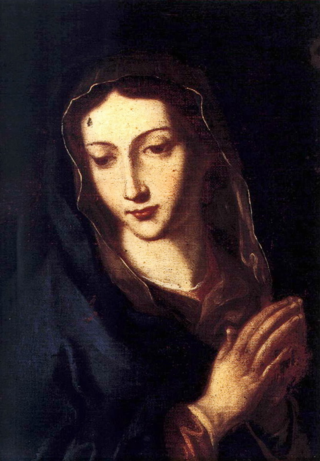
Panagiotis Doxaras (1662–1729) also known as Panayiotis Doxaras, was an author and painter. He was a prolific member of the Heptanese School. He was influenced by early members of the movement namely: Elias Moskos, Theodoros Poulakis, Stephanos Tzangarolas, Spyridon Sperantzas and Victor. The Heptanese School evolved during the Baroque period and continued into the Late Baroque or Rococo. Doxaras’s son Nikolaos Doxaras continued the artistic movement into the Neoclassical era. Both Panagiotis and his son Nikolaos Doxaras refined the school. The school was heavily influenced by the Venetian Style. The Heptanese School also influenced Italian painting. Other artists Doxaras influenced were Nikolaos Kantounis. Panagioti’s teacher was famous painter Leos Moskos. He studied with him while he was in Venice. Doxaras painted notable portraits of Johann Matthias von der Schulenburg. He introduced Maniera Italiana to the Heptanese School drastically changing the style from the Maniera Greca. He is considered the father of the Greek Rococo and the Modern Greek Enlightenment in art.

San Giorgio dei Greci is a church in the sestiere (neighborhood) of Castello, Venice, northern Italy. It was the center of the Scuola dei Greci, the Confraternity of the Greeks in Venice. Around this period there was a similar church in Naples called Santi Pietro e Paolo dei Greci. There was also a Greek Brotherhood of Naples.

Theodore Poulakis was a Greek Renaissance painter and teacher. He is considered the father of the Heptanese School and one of the most prolific painters of Venetian Crete. Poulakis was a member of the Cretan School, his contemporary was Emmanuel Tzanes. Emmanuel Tzanes and Poulakis were active painters of the Cretan School until Candia, went to war with the Ottomans around 1649. Candia finally fell after twenty years of siege in 1669. Poulakis settled on the island of Corfu. Stephanos Tzangarolas was another famous painter in Corfu around the same period. Poulakis's works are likened to Andreas Pavias and Georgios Klontzas. Poulakis works exhibit qualities of the Venetian school. Over 130 of his paintings have survived and can be found all over the world.
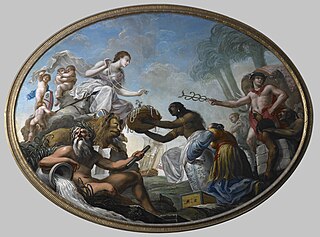
Spiridione Roma, also known as Spiridon or Spyridon Romas, was a Greek painter from Corfu. He was a prominent member of the Heptanese School. His contemporary was Spyridon Sperantzas. He was another painter from Corfu. He also painted all over Italy and settled in Triste. Romas painted on the Ionian Islands, Sicily, and Livorno before settling in England. He was one of the few Greek painters to travel to a foreign country outside of the Greek or Italian world. The other two were El Greco and Efstathios Altinis. He was also a British painter during the last decades of his life. He was active in the region from 1770 to 1786. According to the Hellenic Institute, over twenty-five of his works survived. He was the British El Greco. His most popular work is a painting entitled The East Offering its Riches to Britannia.

Ilias or Elias Moskos was a Greek educator, shipping merchant and painter from Crete. The last name Moskos was associated with three famous painters of the Cretan School alive during the same period, along with Ioannis Moskos and Leos Moskos, possibly his relatives. Elias incorporated maniera greca with the Venetian style. Theodore Poulakis and Moskos brought the art and style of Crete into the Heptanese School of the Ionian Islands. Some of his work was inspired by Angelos Akotantos. He was affiliated with other artists such as Philotheos Skoufos. He is often confused with Leos Moskos. His son was not Ioannis Moskos although they were probably related. Elias most popular painting is Christ Pantocrator. Fifty-two of his paintings survived.

Ιoannis Apakas, also known as Johann Apakass was a Greek painter and priest. He was active in the latter part of the 16th century to the early 17th century. He was popular artist during his time.
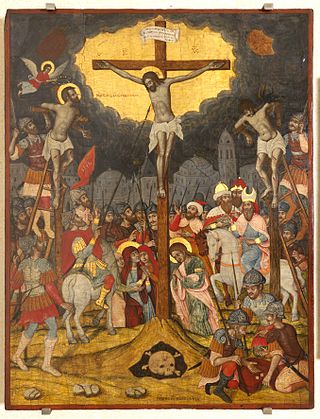
Ioannis Moskos was a Greek painter that migrated to Venice. Two other very famous painters with the name Moskos were active around the same period Elias Moskos and Leos Moskos. Leos Moskos frequently traveled all over the Venitian Empire and was in Venice around the same period as Ioannis. He is not Elias Moskos's son. The Moskos painters may have had some relationship but documentation is unavailable. Ioannis painted in the traditional maniera greca and the Venetian style. His art resembles Michael Damaskinos and Andreas Pavias. He was affiliated with the church of San Giorgio dei Greci. He left a huge assortment of paintings that can be found all over the world. His most popular work is The Crucifixion.

Stephanos Tzangarolas also known as Stephano Tzangarola. He was a Greek painter during the late Cretan Renaissance. He migrated from Crete to the island of Corfu. He is a member of the Heptanese School and the Cretan Renaissance. His contemporaries at the time were Panagiotis Doxaras, Theodore Poulakis and Elias Moskos. His artwork began to reflect the transition of the classical maniera greca of Crete to the more refined style of the Ionian Islands. His style resembles the transition of Gentile da Fabriano and Fra Angelico from the maniera greca to their respective styles. Tzangarolas paintings influenced countless artists both Italian and Greek. Some artists that reflect his style include Spyridon Sperantzas and Georgios Kastrofylakas. His paintings can be found all over Greece mainly Athens and the Ionian Islands. Some of his work is in Cairo and London. His student was famous Greek painter Andreas Karantinos.
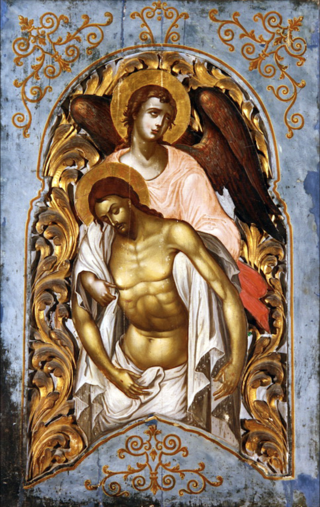
Nikolaos Kallergis, also known as Kalergis. He was a Greek painter during the Greek Rococo and the Modern Greek Enlightenment in art also known as Neo-Hellenikos Diafotismos. His art also exhibited Venetian influence. Painters of the maniera greca began to refine their art. Philotheos Skoufos, Elias Moskos, and Theodore Poulakis were all active painters on the Ionian Islands prior to Kallergis. They set the stage for the transition to the Heptanese School. Panagiotis Doxaras is the forefather of the new painting style. He was the father of Greek Rococo and the Modern Greek Enlightenment in painting. Kallergis became an active member of the school. Kallergis also represents the Greek Rococo. His art began to exhibit qualities of Greek and Italian Neoclassicism. His style influenced countless painters. Examples include Nikolaos Kantounis, Nikolaos Koutouzis, Nikolaos Doxaras, Spiridione Roma, and Eustathios Karousos. His most famous work is Christ and Angel it is at the Zakynthos Museum.

Spyridon Sperantzas was a Greek painter. He flourished during the Greek Neoclassical era and the Modern Greek Enlightenment in art also known as Neo-Hellenikos Diafotismos. Because of the Fall of the Republic of Venice, Sperantzas brought the Heptanese School into the Greek Romantic period. By the 1800s the Ionian Islands were occupied by both French and English forces and for the first time since the fall of the Byzantine Empire, the local Greeks governed themselves. Sperantzas, Nikolaos Kantounis, and Nikolaos Koutouzis represent the transition in painting that defined Modern Greek art. Sperantzas was influenced by Nikolaos Kallergis, Nikolaos Doxaras, and Nikolaos Koutouzis. His son Michael Sperantzas was also a famous painter and his apprentice. Spyridon also painted frescos.

Emmanuel Skordilis, also known as Emmanouil Skordilis. He was a Greek Renaissance painter. He was active in Crete around the time Emmanuel Tzanes, Elias Moskos, and Philotheos Skoufos were painting in Crete. He belongs to the elite group of Greek painters that followed the Venetian influenced maniera greca in Crete. Sixty eight of his works survived. He is one of few artists to not travel to the Ionian Islands and participate in the Heptanese School. He eventually settled in the Cyclades on the inland of Milos. Christodoulos Kalergis is another prominent Greek artist associated with the Cyclades, he was from Mykonos. Skordilis was influenced by Georgios Klontzas, Michael Damaskinos and Angelos. Skordilis brought the artistic style of Crete to the Cyclades and influenced countless artists in that region.

Andreas Karantinos, also known as Andreas Karandinos. He was Greek Renaissance painter, educator and goldsmith. He was from Kefalonia. He was a member of the Heptanese School. His artwork is reflective of the time period. His teacher was famous painter Stephanos Tzangarolas. He adapted his style. Karandinos also emulated the Cretan masters such as Michael Damaskinos. Many Greek painters emulated one other. Karandinos also taught famous Greek painter Konstantinos Kokkinos and several others. Many of his works are in Greece mostly on the island of Kefalonia. Twenty two of his work survived and one fresco. The fresco is of the Second Coming or the Last Judgement. The fresco is located in the church of Evagelastria in Kastro Kefalonia.

Ieremias Palladas, also known as PouladasIeremia Pallada. He was a Greek Renaissance painter. He was a clergyman, painter, and educator. He was affiliated with Saint Catherine's Monastery in Mount Sinai, Egypt. He is one of the most notable Greek painters of the 17th century. His family consisted of clergy and painters. His nephew was Patriarch of Alexandria Gerasimos Palladas. His work was influenced by Nikolaos Tzafouris and Angelos Akotantos. Georgios Klontzas and Emmanuel Lambardos were active in Crete around the same period. Palladas influenced the works of Theocharis Silvestros, Iakovos Moskos, Ioannis Kornaros and Philotheos Skoufos. According to the Institute of Neohellenic Research, twenty-four of his works survived. His specialty was painting crosses for the iconostasis or templo. Most of his works are in Egypt.
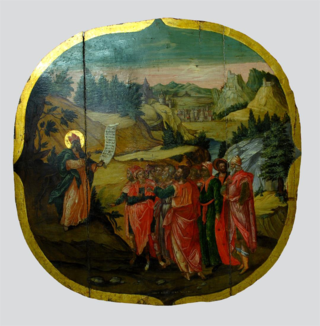
Demetrios Nomikos was a Greek painter, goldsmith, and priest. He shared the same last name with other famous Greek painters. Georgios Nomikos, Demetrios Nomikos and his brother Nicholas Nomikos. He is one of the early representatives of the Heptanese School of painting. He was active during the Greek Baroque and Rococo. He worked with notable Greek painter Antonios Notaras. Konstantinos Kontarinis, Stylianos Stavrakis and Nikolaos Kallergis were active on the same islands around the same period. Nomikos was a master gilder. According to the Institute of Neohellenic Research, five of his works survived. His most notable works are at the Loverdos Museum.

The Virgin and Child on Bronze is an egg tempera painting by Greek painter Elias Moskos. Moskos was originally from Crete. The painter migrated to Zakinthos. Two other painters with the name Moskos were active during his lifetime. They were Ioannis Moskos and Leos Moskos. All three painters were affiliated with Venice. Fifty-two of Elias's paintings survived. It is difficult to characterize the work of some painters belonging to the late Cretan School. Some artists also belong to the Heptanese School. The technical migration from the maniera Greca of Cretan-Venetian painting to the more refined Ionian-Venetian style is visible in the works of Elias Moskos and Theodoros Poulakis. His painting of the Virgin and Child drastically migrates from the traditional mannerism prevalent in Cretan painting. The painting clearly belongs to the Heptanese School. His painting of the Virgin and Child is at the Benaki Museum in Athens Greece.

Constantine and Helen is a painting by Ioannis Moskos. He was a prolific Greek painter associated with Venice and the Ionian Islands. He flourished during the Late Cretan School and early Heptanese School. Three painters with the same last name were active during the same period, the other two were Leos Moskos and Elias Moskos. Ioanni's painting style demonstrates the transition from the Late Cretan School to the early Heptanese School. He began to integrate components prevalent in the Rococo. He was a Baroque artist. According to the Neo-Hellenic Institute, forty-four of his paintings survived.

Jacob’s Ladder is a tempera painting created by Elias Moskos. Elias was a Greek painter originally from the island of Crete. By the 1650s he was living on the island of Zakynthos. He also worked on the island of Kefalonia. There were two other painters active during his lifetime with the same last name. Ioannis Moskos and Leos Moskos. The painter was also a prominent teacher. He also had a sizable fortune. Fifty-two of his paintings survived. He represented the Cretan School and the Heptanese School. His works typically combine both schools. His work was heavily influenced by engravings from all over the world some were Flemish. His artistic activity ranged from 1629 to 1687. Most of his remaining works are in Greece and Italy.
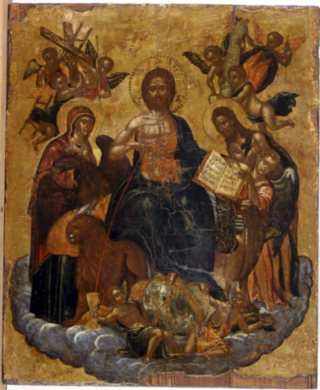
Tribute to the Eucharist was a painting made of egg tempera and gold leaf on a wood panel. The portable icon is attributed to Greek painter Michael Damaskinos. Damaskino's existing catalog features over 100 known works. He was a member of the Cretan school of painting. He was from the island of Crete. His contemporaries were Georgios Klontzas and El Greco. Damaskinos traveled all over Italy for over twenty years. He spent a significant amount of time in Venice. He adopted Italian mannerisms. He applied these new attributes to his paintings. He was friends with sculptor Alessandro Vittoria. He had a collection of drawings obtained from other Italian artists. Namely the Mannerist Parmigianino. He was also exposed to the magnificent works of Italian painter Raphael.

The Virgin and Child Enthroned is a tempera painting created by Spyridon Romas. He was a Greek painter from the island of Corfu and a prominent member of the Heptanese School active from 1745 to 1786 in Corfu, Lecce, Livorno, and London. Twenty-five of his works survived according to research completed by the Hellenic Institute. One of few Greek painters that changed his style completely Romas transitioned from the Heptanese School to the British style of painting. He traveled to London, England around 1770, and remained in the country until his death. Romas painted several portraits but also maintained art. An important iconostasis containing most of his works is preserved in Livorno, Italy at the Museo della Città di Livorno.






















